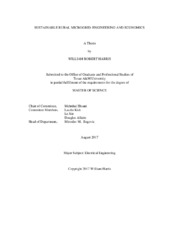| dc.description.abstract | Traditional electrification strategies focused on centralized grid expansion are financially infeasible for extending electricity connections to millions of rural households in developing countries. Instead, estimates predict mini-utilities and off-grid approaches will need to provide electricity to at least 154 million households if universal electrification is to be reached by the target of 2030 set by the United Nations’ Sustainable Energy for All Initiative. Additionally, the large populations within developing countries and predictions of future electricity consumption suggest that fossil fuel-based electrification strategies for these countries would vastly increase the volume of greenhouse gas (GHG) emissions per annum and should be avoided. Renewable technologies such as photovoltaic (PV) arrays, wind turbines, and biomass gasifiers provide sustainable energy alternatives. With the advent of such renewable technologies, DC microgrids are increasingly advantageous compared to AC systems in rural applications, predominantly due to the reduction of AC to DC power conversions and native DC tendency of loads. A holistic methodological approach to designing a miniutility is described in this thesis, including technical, financial, and managerial considerations.
Microgrid architecture topologies are proposed in this thesis, including photovoltaic, biomass gasifier, and wind turbine generators as well as generator hybridization topologies. Rural systems have unique design challenges due to their consumers’ low purchasing power, sparse population density, minimal power consumption and tendency for slow growth. Sizing generators appropriately is paramount. In many cases, detailed renewable resource data may be unavailable, a condition taken into consideration by utilizing publicly available low-resolution global climate datasets from NASA for generator sizing purposes. Power converter topologies are also briefly discussed. As an example, a microgrid topology and business model is constructed for a model village case study using the methodology and architectures described in this thesis. The results of the case study highlight the limitations of minimizing net preset cost as an optimization objective and instead propose maximum average cost to period as an alternative metric for comparison. Additionally, longer loan periods are found to favor capital-intensive microgrid architecture, such as solar and wind technologies. | en |


